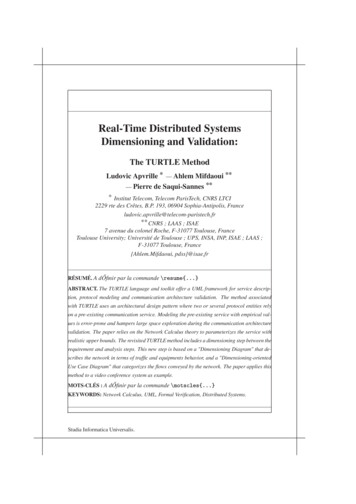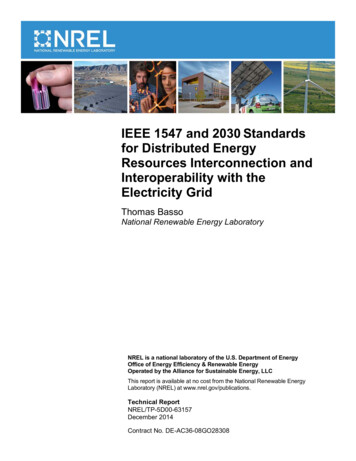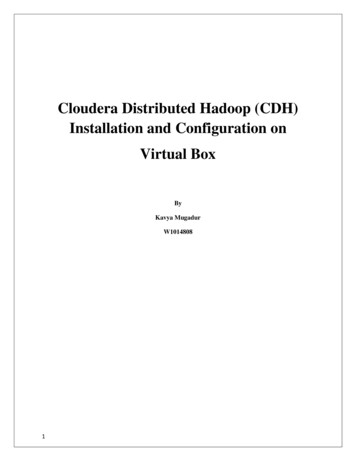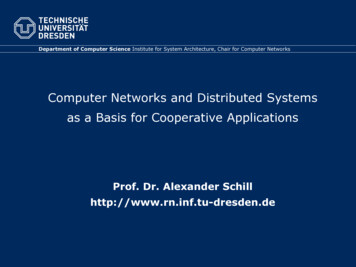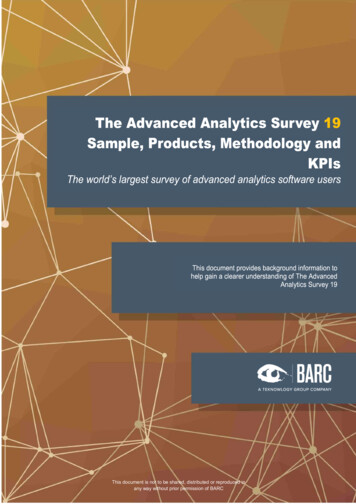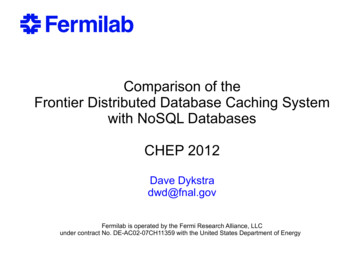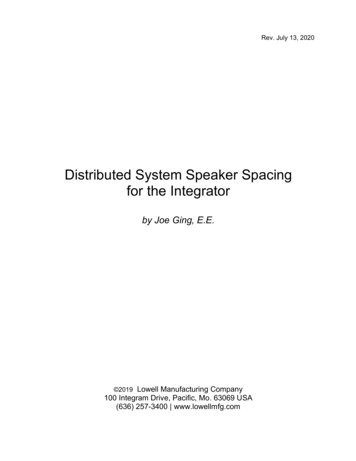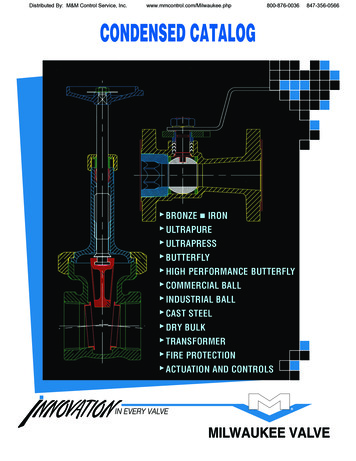
Transcription
IT 11 075Examensarbete 30 hpOktober 2011Evaluation and Implementationof Distributed NoSQL Databasefor MMO Gaming EnvironmentYousaf MuhammadInstitutionen för informationsteknologiDepartment of Information Technology
AbstractEvaluation and Implementation of Distributed NoSQLDatabase for MMO Gaming EnvironmentYousaf MuhammadTeknisk- naturvetenskaplig orietLägerhyddsvägen 1Hus 4, Plan 0Postadress:Box 536751 21 UppsalaTelefon:018 – 471 30 03Telefax:018 – 471 30 00Hemsida:http://www.teknat.uu.se/studentMassively Multi-player Online Games have emerged as a most intensive dataapplication nowadays. Being massively used by simultaneously game players aroundthe world. This data require high level of performance, fault tolerance and scalability.Distributed databases are one of the option we got for this kind of systems. The goalis to give game players a high level of availability, fault tolerance and speed of thedatabase. So that the growing need of the players can be handled. NoSQL distributeddatabases are nowadays are getting popularity for their opensourse, non relationaldata stores, high performance, scalability and fault tolerance. Traditional relationaldatabases like MySQL, PostgreSQL seems to be loosing interest among the databasedeveloper. NoSQL databases which includes Riak, CouchDB, Cassandra are rapidlygaining interest because of there advantages over traditional databases. This study isabout choosing the best and reliable distributed database among SQL and NoSQL.Pikkotekk AB provides network traffic load balancing services to the game developersfor their games. PikkoTekk have load balancing servers known as Pikkoservers thatworks fully transparent to the game and fulfill all the requirement of massively multiplayer online user that interacts with game all together.Handledare: Christian LönnholmÄmnesgranskare: Justin PearsonExaminator: Anders JanssonIT 11 075Tryckt av: Reprocentralen ITC
Contents1 Introduction . . . . . . . . . . . . . . . . . . . . . . . . . . . . . . . . . . . . . . . . . . . . . . .31.1 Research background . . . . . . . . . . . . . . . . . . . . . . . . . . . . . . . . . . . . . . . . .31.2 Task of the thesis: . . . . . . . . . . . . . . . . . . . . . . . . . . . . . . . . . . . . . . . . . . .41.3 Outline of Thesis: . . . . . . . . . . . . . . . . . . . . . . . . . . . . . . . . . . . . . . . . . . .42 Theoretical Basis: . . . . . . . . . . . . . . . . . . . . . . . . . . . . . . . . . . . . . . . . . . . .52.1 SQL: (Structured Query Language) . . . . . . . . . . . . . . . . . . . . . . . . . . . . . . . . .52.2 Difference Between NoSQL and SQL: . . . . . . . . . . . . . . . . . . . . . . . . . . . . . . . .53 Analysis. . . . . . . . . . . . . . . . . . . . . . . . . . . . . . . . . . . . . . . . . . . . . . . . .3.1 Requirement of Distributed Database:7. . . . . . . . . . . . . . . . . . . . . . . . . . . . . . .73.1.1 Distributed Database Advantages: . . . . . . . . . . . . . . . . . . . . . . . . . . . . . .83.2 Databases: . . . . . . . . . . . . . . . . . . . . . . . . . . . . . . . . . . . . . . . . . . . . . . .93.2.1 MySQL . . . . . . . . . . . . . . . . . . . . . . . . . . . . . . . . . . . . . . . . . . . . 103.2.2 CouchDB: . . . . . . . . . . . . . . . . . . . . . . . . . . . . . . . . . . . . . . . . . . . 113.2.3 Riak . . . . . . . . . . . . . . . . . . . . . . . . . . . . . . . . . . . . . . . . . . . . . . 123.3 Description of selected solution: . . . . . . . . . . . . . . . . . . . . . . . . . . . . . . . . . . . 134 Riak - A Distributed database for Distributed system. . . . . . . . . . . . . . . . . . . . . . .154.1 Data Storage in Riak: . . . . . . . . . . . . . . . . . . . . . . . . . . . . . . . . . . . . . . . . . 154.2 Client Libraries in Riak: . . . . . . . . . . . . . . . . . . . . . . . . . . . . . . . . . . . . . . . 154.3 Clustering in Riak: . . . . . . . . . . . . . . . . . . . . . . . . . . . . . . . . . . . . . . . . . . 164.4 The CAP Theorem: . . . . . . . . . . . . . . . . . . . . . . . . . . . . . . . . . . . . . . . . . . 174.4.1 SQL, NoSQL Databases Vs CAP theorem: . . . . . . . . . . . . . . . . . . . . . . . . . . 174.5 Replication In Riak: . . . . . . . . . . . . . . . . . . . . . . . . . . . . . . . . . . . . . . . . . . 184.5.1 R Value and Read Fault Tolerance: . . . . . . . . . . . . . . . . . . . . . . . . . . . . . 194.5.2 W Value and Write Fault Tolerance: . . . . . . . . . . . . . . . . . . . . . . . . . . . . . 194.5.3 Conflict Handling in Riak: . . . . . . . . . . . . . . . . . . . . . . . . . . . . . . . . . . 194.6 HTTP Interface: . . . . . . . . . . . . . . . . . . . . . . . . . . . . . . . . . . . . . . . . . . . . 204.7 Components of Riak: . . . . . . . . . . . . . . . . . . . . . . . . . . . . . . . . . . . . . . . . . 204.7.1 RiakSearch: . . . . . . . . . . . . . . . . . . . . . . . . . . . . . . . . . . . . . . . . . . 205 Implementation Environment:. . . . . . . . . . . . . . . . . . . . . . . . . . . . . . . . . . . .225.1 Erlang: . . . . . . . . . . . . . . . . . . . . . . . . . . . . . . . . . . . . . . . . . . . . . . . . . 221
5.2 Looby Server: . . . . . . . . . . . . . . . . . . . . . . . . . . . . . . . . . . . . . . . . . . . . . 225.3 Unity: . . . . . . . . . . . . . . . . . . . . . . . . . . . . . . . . . . . . . . . . . . . . . . . . . 245.4 Database Design: . . . . . . . . . . . . . . . . . . . . . . . . . . . . . . . . . . . . . . . . . . . 245.5 Interfacing With Riak Database: . . . . . . . . . . . . . . . . . . . . . . . . . . . . . . . . . . . 275.5.1 Socket Server Interface: . . . . . . . . . . . . . . . . . . . . . . . . . . . . . . . . . . . 285.5.2 Data Servers: . . . . . . . . . . . . . . . . . . . . . . . . . . . . . . . . . . . . . . . . . 295.5.3 C# Interface: . . . . . . . . . . . . . . . . . . . . . . . . . . . . . . . . . . . . . . . . . 316 Testing and Evaluation:. . . . . . . . . . . . . . . . . . . . . . . . . . . . . . . . . . . . . . . .336.1 Testing by Integrating with The Game: . . . . . . . . . . . . . . . . . . . . . . . . . . . . . . . 336.2 System Performance Evaluation:. . . . . . . . . . . . . . . . . . . . . . . . . . . . . . . . . . 346.2.1 CouchDB Vs MySQL VS Riak Under 1 node Cluster: . . . . . . . . . . . . . . . . . . . . 346.2.2 Comparison Between 1 and 2 Riak Nodes: . . . . . . . . . . . . . . . . . . . . . . . . . 386.2.3 Riak Benchmark Evaluation: . . . . . . . . . . . . . . . . . . . . . . . . . . . . . . . . . 427 Conclusion . . . . . . . . . . . . . . . . . . . . . . . . . . . . . . . . . . . . . . . . . . . . . . . .448 References . . . . . . . . . . . . . . . . . . . . . . . . . . . . . . . . . . . . . . . . . . . . . . . .452
Acknowledgement:First of all, I would like to praise to almighty ALLAH for all the favours and mercifulness that bestowedupon me not only for completing my Master thesis project but for everything that I have had achieved yet.Secondly, I want to acknowledge my thanks to my supervisor Christian Lonnholm, Bjorn Dahlman and myreviewer Justin Pearson for helping me out at different stages of my project.Finally, my gratitude goes to my parents who always help me in achieving my desires in life.3
1Introduction1.1Research backgroundTraditional SQL RDBMS (Structured Query Language Relational Database Management System) are hard toscale to the sheer amount of data and how to connect internally. One way to address this problem is byusing NoSQL database. The more interactivity of the gaming environment in modern days have attractedmore game users. In effect, the data generated through such multi-player network games are increasingrapidly. So proper data management and data handling is the need of today for improving speed, reliabilityand scalability of these gaming applications. Distributed database is the best bet among all.PikkoTekk AB [PKT] provides state of the art network traffic load balance solutions to the video games.So that unlimited number of players can join one game or multi-game at one time.Figure 1: PikkoTekk ArchitectureFigure 1 shows the Pikko architecture that has the ability to handle large number of identical singlethreaded game server. Pikko architecture provides appealing programming environment for the game developers and game servers developer by providing them an option to have a power of horizontal scalabilityby running game server on single thread.Any database whether its a SQL or NoSQL can fit into Pikko architecture. For high performance, scalability and fault tolerance modern distributed NoSQL database is recommended.Game Server:The Pikko server software consists of Pikko server(Game Sever) and several cell servers.Player in an online multiplayer game connect to the Pikko server, which handles load balancing between cellservers. The cell servers handles physics, game logic and more.4
LobbyServer:Lobby server gives user the platform to host the game, switching to other game, chattingamong users in network and enjoy other features apart from playing games only. It makes them socializeand have an interactive gaming environment to spend more time on gaming.1.2Task of the thesis:Video games industry has had a rapid growth over the past few years. According to the statistics by [PKT],the sales of video games were 16 billion in 2007 and it is expected to grow over in upcoming years. This isdue to fact that technological growth which include high speed broadband take over the slow dial up networkaccess, video games in portable devices, multi player online games and rapid development of games by gamedevelopers.The aim of this thesis is to perform exhaustive comparison of NoSQL databases. Further, evaluate thesedistributed NoSQL databases by their performance and advantages in distributed environment. Finally,design and implementation of the database by testing it on real time distributed application.Selection of the Database for the distributed application will depend upon the performance and scalabilityof the compared NoSQL database.In MMO Massively Multi player modern online games, apart from playing games socializing throughchat, joining and switching between different game environments, automated and manual hosting of gamesare common features. To keep track of such large amount of user data in between sessions we normally usea database backend. As the user activities normally span multiple servers, a distributed database suits thistask well. As scalability, availability and concurrency puts high pressure on the persistence of the database,a smart design is needed to make transactions fluent.1.3Outline of Thesis:1. Chapter 2 defines SQL, NoSQL and key difference between them.2. Chapter 3 explains theoretical background which includes, Distributed Systems and comparison betweensome popular SQL and NoSQL databases.3. Chapter 4 gives a brief introduction about Riak.4. Chapter 5 introduces the process of Implementation and introduction of tools used.5. Chapter 6 introduces a tests and performance evaluation of the databases.6. Chapter 7 concludes the thesis.5
2Theoretical Basis:This chapter will explains some important concepts that relate to the thesis.2.1SQL: (Structured Query Language)SQL is a one of many database language that can be used for querying and modifying relational databases.In Relational databases data is stored in RDBMS (Relational Database Management System).A database management system is a set of software programs that controls the organization,storage, management and retrieval of data in a database. [DBM]in Wikipedia 25/06/2011In RDBMS data is stored in database tables. These tables are database objects and the most commonform of data storage in RDBMS. Each table in the database is divided in to small entities called field. Fieldsare also called as columns of the data. Rows of the data consist of each individual entry in fields of the data.Some RDBMS that uses SQL as there data manipulation language are Microsoft SQL server, Oracle,MySQL, Mircosoft Access and Sybase etc. The most common and widely used SQL statements are Select,Insert, Update, Delete, Create and Drop. By using these common and standard statements we can do prettymuch anything with the database.Microsoft SQL Server:Microsoft SQL Server is one of the most popular database among relation data-bases. SQL server is not only a database it is also a complete management system. Apart from the commonfunctionality of the database SQL server also comes with the addition tools like manipulation, report writing,data import export, data structure and management.Oracle:Oracle is considered as world leading relational database. Oracle was the first database thatsupport SQL as a manipulation language. [SOra]2.2Difference Between NoSQL and SQL:NoSQL is an umbrella term designating a group of non-relational database systems or key-value stores.A common trait to these systems is that usually they, in contrast to relational databases do not need afixed table structure. Their strong point is their distributivity, making them particularly suitable for scalingup. Traditional database systems are known for their continuous consistency, which is traded for betteravailability or partition tolerance in NoSQL databases.6
The key difference between NoSQL and SQL is that NoSQL provide schema less data model that resultsin faster read and writes in the database as compared to SQL.Some of the commonly used NoSQL databases are CouchDB, Riak, Cassandra, Mnesia, BerkeleyDB, HamsterDB, MongoDB and Redis etc. All NoSQL databases have there own advantages and drawbacks in term ofstorage, performance and availability.[LND] describes families and list of complete set of NoSQL databases.Mnesia: Mnesia is a NoSQL database that is considered as an Object relational DBMS. It has all thecharacteristics of DBMS which includes Locking, replication, logging, primary and secondary memory storageetc.Cassandra:Cassandra is known for its high scala
NoSQL databases which includes Riak, CouchDB, Cassandra are rapidly gaining interest because of there advantages over traditional databases. This study is about choosing the best and reliable distributed database among SQL and NoSQL. Pikkotekk AB provides network traffic load balancing services to the game developers for their games. PikkoTekk have load balancing servers known as



